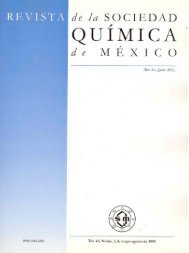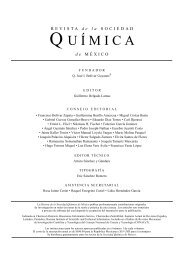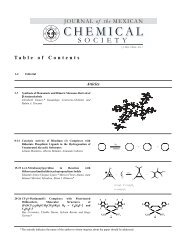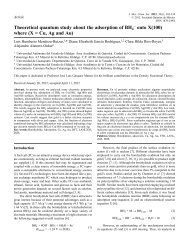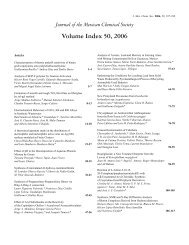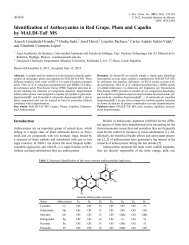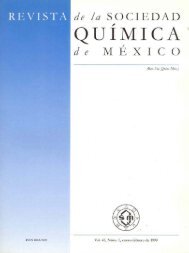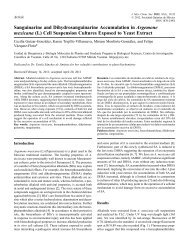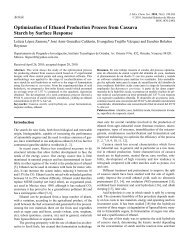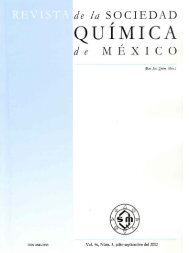SMQ-V047 N-002_ligas_size.pdf - Journal of the Mexican Chemical ...
SMQ-V047 N-002_ligas_size.pdf - Journal of the Mexican Chemical ...
SMQ-V047 N-002_ligas_size.pdf - Journal of the Mexican Chemical ...
Create successful ePaper yourself
Turn your PDF publications into a flip-book with our unique Google optimized e-Paper software.
120 Rev. Soc. Quím. Méx. Vol. 47, Núm. 2 (2003) Eduardo Díaz et al.<br />
Fig. 3.<br />
O<br />
O<br />
O<br />
O<br />
O<br />
O<br />
7 9a<br />
O<br />
O<br />
O<br />
O<br />
O<br />
7<br />
9a'<br />
O<br />
O<br />
O<br />
O<br />
O<br />
O<br />
O<br />
O<br />
1 9<br />
O O<br />
O<br />
O<br />
O<br />
O<br />
1<br />
Scheme 3<br />
O O<br />
O<br />
O<br />
O<br />
** *<br />
O<br />
** *<br />
**<br />
*<br />
**<br />
*<br />
O<br />
O<br />
O<br />
O<br />
9'<br />
309, (M + 2) m/z 311, (M + 4) m/z 313, and (M + 6) m/z<br />
316]. The proton NMR spectrum showed a one proton doublet<br />
<strong>of</strong> doublet δ = 7.12 (J = 15.5, 10.5 Hz) and an one proton<br />
doublet <strong>of</strong> doublet at δ = 6.41 (J = 0.5, 15.5) for CH-10 and<br />
CH-11 respectively. A new methylene signal appeared at δ =<br />
4.22 instead <strong>of</strong> <strong>the</strong> usual methyl ketone singlet (δ = 2.31)<br />
observed in <strong>the</strong> 1 HNMR spectrum <strong>of</strong> starting β-ionone 1 (Fig.<br />
3).<br />
Additionally, we were able to observe a doublet <strong>of</strong> doublet<br />
at δ = 2.40 (J = 10.5, 0.5, CH-2) and three methyl singlets<br />
at δ = 1.30, 0.95 and 0.78 for C-7, C-8, and C-9 respectively.<br />
The 1D 13 C NMR and DEPT edited spectra allowed <strong>the</strong><br />
assignment <strong>of</strong> protonated carbons as four methines at δ =<br />
148.0 (C-10), 129.1 (C-11), 48.1 (C-2) and 32.8 (C-6) respectively.<br />
Three methylenes at δ = 47.2, (C-13), 35.1 (C-4) and<br />
15.9 (C-5). Three methyl signals were also observed at δ =<br />
29.4, 22.5, 19.7 for C-8, C-7 and C-9 respectively. The assignment<br />
<strong>of</strong> <strong>the</strong> non protonated carbons at δ = 190.5 (C-12), 72.8<br />
(C-14), 32.0 (C-3) and 29.8 (C-1) was performed using <strong>the</strong><br />
COLOC [18] spectrum.<br />
The formation <strong>of</strong> compounds 10 and 11 may be inferred<br />
through isomerization [22-26] <strong>of</strong> <strong>the</strong> bond C6-C1 from compound<br />
1' to 1 respectively and <strong>the</strong>n <strong>the</strong> dichlorocarbene addition<br />
to <strong>the</strong> new formed double bond.<br />
On <strong>the</strong> o<strong>the</strong>r hand, <strong>the</strong> role <strong>of</strong> <strong>the</strong> catalyst used in this<br />
work, play an important role in <strong>the</strong> ratio <strong>of</strong> <strong>the</strong> products<br />
obtained as well as <strong>the</strong> versatility <strong>of</strong> <strong>the</strong> structures and yield.<br />
Graphics 1 and 2 are self explained and show <strong>the</strong> behaviour <strong>of</strong><br />
<strong>the</strong> different catalyst and ratio <strong>of</strong> products.<br />
O<br />
O<br />
O<br />
O<br />
O<br />
O<br />
Conclusions<br />
Scheme 4<br />
-1<br />
11 6.0 Kcal mol<br />
O<br />
O<br />
135.0 Kcal mol -1<br />
O<br />
-1<br />
135.5 Kcal mol<br />
The successful use <strong>of</strong> several ammonium quaternary catalyst<br />
in <strong>the</strong> phase transfer reactions enabled us to obtain some interesting<br />
derivatives from <strong>the</strong> starting material (β-Ionone). The<br />
structures <strong>of</strong> <strong>the</strong> formed compounds where fully elucidated




